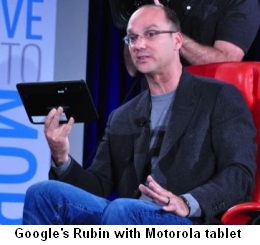有一波浪头超高的“移动装置海啸(mobile tsunami)”将在2011年抵达,这会是最新一波,而且可能是这几年来力道最强的——从这些日子以来的产业动态,就可看出以上趋势。
谷歌(Google)日前在美国硅谷举行了一场记者会,宣告其Chrome操作系统即将问世;该软件平台将催生仅通过云技术链接各种应用程序的运算装置。为了推广目前仍运行在一台笔记本电脑原型机的这套操作系统,谷歌展开了大规模的测试计划以及草根营销活动。
与此同时,谷歌的手机教父Andy Rubin于旧金山展示了在平板电脑应用上做了优化的下一代Android;该代号为“Honeycomb”的操作系统(编按:是接替代号“姜饼人”的Android 2.3的下一个版本Android),会用一种被称为“分段式(fragments)”的概念,让用户能将应用程序打散成可视对象(viewable piece),以某种形式呈现在其4英寸智能手机屏幕,又以另一种形式呈现在7~10英寸的平板电脑屏幕上。
Rubin是在一场由华尔街日报(Wall Street Journal)所赞助举办的会议上,用一台摩托罗拉(Motorola)的平板电脑原型机展示预计明年问世的Honeycomb;他在展示中运行了新版本的Google Map,是以向量(vector)方式而非块状数据(tile data)呈现,因此能以质量更优的3D图像支持更顺畅的导航。Rubin透露,该平板电脑的处理器可能是Nvidia的多核心Tegra芯片。
“我们选出一组合作伙伴——包括一家半导体供应商、一家电信服务业者,以及一家OEM,而这种装置是大家每天在工作上都会用到的;”Rubin所阐述的设计理念,更接近苹果(Apple)而非微软(Microsoft):“它让硬件与软件更紧密地整合。”他顺带一提,谷歌的Android团队营利,主要是来自透过使用其免费操作系统的手机广告销售。
在同一场会议上,RIM(Research in Motion)的共同执行官Mike Lazaridis则通过多媒体与通信功能丰富的易用应用程序,展示其Playbook平板电脑的多任务特性;RIM显然是把所收购的QNX与The Astonishing Tribe,融合成如Lazaridis所言、是采取一种多核心策略的强大软件平台。

点击进入第二页:多核心处理器将是推动新一波移动装置海啸的主要力量
{pagination}
因此我们可预见,在2011年将有由谷歌与RIM所提供的两个新移动平台;还有惠普(HP)也曾在电话会议上,派遣前任Palm执行官Jon Rubinstein公开宣告,明年将会有一系列采用WebOS的平板电脑与智能手机问世。无论以上这些厂商的产品会成功或失败,你可以想见他们的目标都是很高的,而且他们拥有全球最大计算机制造商与芯片买主的支持。
别忘了还有诺基亚(Nokia),这家全球最大手机厂的新任执行官Stephen Elop正悄悄地规划一条新路线,更偏向于支持与英特尔(Intel)共同开发的MeeGo平台、而非自家的传统Symbian操作系统。英特尔很久以前就透露,将为诺基亚手机提供32纳米制程的Atom芯片,以做为其进军智能手机的前哨,预期在2011年稍晚会有相关讯息。
当然,苹果也不会让众多粉丝失望,预期将会在明年推出iPad 2与iPhone 5——除非在苹果位于美国加州Cupertino的总部出现大地震。也别忘了三星(Samsung),这家全球第二大芯片制造商、前几大手机厂,将以自家双核心Orion芯片与Galaxy系列智能手机与平板电脑,在2011年引起市场骚动。
来自苹果、英特尔、Nvidia、高通(Qualcomm)、三星(Samsung)、德州仪器(TI)等厂商的,强悍且具备低功耗特性的多核心处理器,将是推动新一波移动装置海啸的主要力量;这些芯片供应商将在这波大浪潮中,像踩着冲浪板一样,抢搭上最新型平板电脑、电子书阅读器、智能手机等等装置。
可能得经过几年的时间,这场海啸才会逐渐消退,好让众人看到在一片混战中,是哪些系统与芯片有幸取得成功。只要半导体制程技术能持续进展,这一波浪头看来就能持续下去,而其力道看来还能撑到另一个十年。
笔者记得,在1988年开始报导这个产业的讯息时,曾在惠普位于香港的的亚洲区总部看到一幅壁画,描述了运算技术的演进,计算机从一台需要众人分享的大型主机(mainframe),逐渐缩小为团体分享的中型Unix系统,然后才是个人计算机(PC);当时的处理器还只到Intel 386。现在,准备好迎接一个人人拥有移动计算机的时代,其中有些才刚被发明或者是重新发明出来。
点击进入参考原文:Mobile tsunami makes landfall in 2011
《电子工程专辑》网站版权所有,谢绝转载
{pagination}
Mobile tsunami makes landfall in 2011
Rick Merritt
Head for high ground. A mobile tsunami will hit in 2011. It's the latest, and perhaps tallest wave in a high tide that has been rising for the last several years.
Sightings of this new high watermark were observed up and down the coast this week.
In Silicon Valley, Google held a press event trumpeting the coming of its Chrome OS, the software meant to power devices using only cloud-based applications. Google launched a broad beta program and grassroots marketing campaign for the environment now running in a prototype laptop.
Meanwhile in San Francisco, Google's mobile guru Andy Rubin showed the next version of Android optimized for tablets. The Honeycomb operating system will use the concept called fragments to let developers break their applications into viewable pieces that could be presented one way on the four-inch display of a smartphone and another way on a 7-to-10 inch display of a tablet.
Rubin showed Honeycomb due next year running on a prototype Motorola tablet at an event sponsored by the Wall Street Journal. He demoed it running a new version of Google Maps based on vector rather that tile data for smoother navigation with better 3-D graphics. Rubin suggested the tablet's processor might be a multicore Nvidia Tegra chip.
"We pick one [set] of our partners--a semiconductor partner an operator and an OEM and this is the device everyone has on their desk in the morning," said Rubin explaining a design philosophy he said was more aligned with Apple than Microsoft. "It makes a much tighter integration of hardware and software," he said.
Incidentally, he said Google's Android group is profitable based on sales of mobile ads via its free operating system.
At the same event Research in Motion co-chief executive Mike Lazaridis showed the Playbook tablet multitasking through multiple media- and communications-rich applications with ease. RIM clearly is melded its acquisitions of QNX, The Astonishing Tribe and more into a powerful software platform for what Lazaridis said is a multicore strategy.
So we can expect two new mobile platforms from Google in 2011 and one from RIM. Then there's Hewlett-Packard which has sent former Palm chief executive Jon Rubinstein on the conference circuit to let everyone know a new set of WebOS based tablets and smartphones are coming next year. Whether they rise or fall, you know they are aiming high and have backing from the world's biggest computer maker and chip buyer.
Don't forget Nokia, the world's biggest cellphone maker. Its new chief executive Stephen Elop is now quietly plotting a course that seems to be steering more to the MeeGo platform co-developed with Intel than to its traditional Symbian environment. Intel telegraphed long ago its work to get a 32nm Atom chip into a Nokia handset as its entry into smartphones and has said to expect news in late 2011.
Of course Apple will delight its fan base with an iPad2 and iPhone5 next year—unless there is a major earthquake centered in Cupertino. Calif.
And don't forget Samsung, the world's second biggest chip maker and one of the top tier cellphone makers. The intersection of its dual-core Orion chip and its Galaxy smartphones and tablets will cause a stir in 2011.
Muscular, low power multicore processors from Apple, Intel, Nvidia, Qualcomm, Samsung, Texas Instruments and others are driving this next wave. They will ride the new tablets, readers, smartphones and other devices like surfboards on this tsunami.
It may take years before the tide recedes enough to reveal which systems and chips had the good fortune to succeed amid the chaos. This swell will last as long as semiconductor process technology can continue to turn the crank which looks to be at least another decade.
I remember seeing a poster at HP's Asia headquarters in Hong Kong's tony Bond building back in 1988 when I was just starting to cover this industry. It traced the history of computing from the mainframe Stone Age in which everyone shared one big computer to the minicomputer era in which small groups shared middling Unix systems to the modern days of the PC just then dawning with the Intel 386.
Get ready for the era in which we all own multiple mobile computers. Some of them are just now being invented and re-invented.